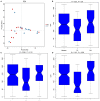Comparative Study on Jejunal Immunity and Microbial Composition of Growing-Period Tibetan Pigs and Duroc × (Landrace × Yorkshire) Pigs
- PMID: 35548051
- PMCID: PMC9085446
- DOI: 10.3389/fvets.2022.890585
Comparative Study on Jejunal Immunity and Microbial Composition of Growing-Period Tibetan Pigs and Duroc × (Landrace × Yorkshire) Pigs
Abstract
The gut microbiota plays vital roles in metabolizing nutrient, maintaining the intestinal epithelial barrier but also in modulating immunity. Host genetics and the pig breed are implicated in shaping gut microbiota. Tibetan pig is a unique native Chinese breed and has evolved to manifest a strong disease resistance. However, the immunity and microbiota of growing Tibetan (TP) pigs were still rarely understood. The jejunal immunity phenotype and microbial composition of TP and Duroc × (Landrace × Yorkshire) (DLY) pigs were explored through immunohistochemistry and 16S rRNA sequencing. Higher scores of clusters of differentiation 4 (CD4+) and Toll-like receptor 9 (TLR9) were observed in TP pigs than those of DLY pigs (p < 0.05), as were Interleukin 10 (IL-10) and zonular occludens 1 (ZO-1) (p < 0.01). Similar levels of bacterial richness and diversity were found in the jejunal microbiota of the TP and DLY pigs. However, the TP pigs showed a significantly different microbiome compared to DLY pigs at the genus level (ANOSIM; p < 0.05). Pseudomonas, Stenotrophomonas, Phenylobacterium, and Sandaracinobacter were enriched in DLY pigs (p < 0.05), while the Lactobacillus and Solibacillus had higher abundances in TP pigs than DLY pigs (p < 0.05). Tibetan pigs have "healthier" intestinal microbial communities than DLY pigs. Close relationships were found between jejunal immune performance and the differential bacteria, Lactobacillus can enhance porcine jejunal immunity, while Stenotrophomonas will have a negative impact on porcine gut immunity.
Keywords: DLY pigs; Tibetan pigs; immune; jejunum; microbial composition.
Copyright © 2022 Yang, Li, Xie, Qiao, Yang and Pan.
Conflict of interest statement
The authors declare that the research was conducted in the absence of any commercial or financial relationships that could be construed as a potential conflict of interest.
Figures






Similar articles
-
Multiomics comparative analysis of feces AMRGs of Duroc pigs and Tibetan and the effect of fecal microbiota transplantation on AMRGs upon antibiotic exposure.Microbiol Spectr. 2024 Nov 29;13(5):e0198324. doi: 10.1128/spectrum.01983-24. Online ahead of print. Microbiol Spectr. 2024. PMID: 39612216 Free PMC article.
-
Comparative Analysis of Structural Composition and Function of Intestinal Microbiota between Chinese Indigenous Laiwu Pigs and Commercial DLY Pigs.Vet Sci. 2023 Aug 16;10(8):524. doi: 10.3390/vetsci10080524. Vet Sci. 2023. PMID: 37624311 Free PMC article.
-
Study on the difference of gut microbiota in DLY and Diqing Tibetan pigs induce by high fiber diet.J Anim Physiol Anim Nutr (Berl). 2025 Mar;109(2):233-242. doi: 10.1111/jpn.14023. Epub 2024 Aug 24. J Anim Physiol Anim Nutr (Berl). 2025. PMID: 39180381
-
Intestinal microbiota could transfer host Gut characteristics from pigs to mice.BMC Microbiol. 2016 Oct 11;16(1):238. doi: 10.1186/s12866-016-0851-z. BMC Microbiol. 2016. PMID: 27729007 Free PMC article.
-
Comparative Analysis of Intestinal Inflammation and Microbiota Dysbiosis of LPS-Challenged Piglets between Different Breeds.Animals (Basel). 2024 Feb 20;14(5):665. doi: 10.3390/ani14050665. Animals (Basel). 2024. PMID: 38473050 Free PMC article.
Cited by
-
Swine farm environmental microbiome: exploring microbial ecology and functionality across farms with high and low sanitary status.Front Vet Sci. 2024 Jul 3;11:1401561. doi: 10.3389/fvets.2024.1401561. eCollection 2024. Front Vet Sci. 2024. PMID: 39021414 Free PMC article.
-
Pig jejunal single-cell RNA landscapes revealing breed-specific immunology differentiation at various domestication stages.Front Immunol. 2025 Feb 28;16:1530214. doi: 10.3389/fimmu.2025.1530214. eCollection 2025. Front Immunol. 2025. PMID: 40151618 Free PMC article.
-
A Comparative Study on the Growth Performance and Gut Microbial Composition of Duroc and Yorkshire Boars.Genes (Basel). 2023 Aug 29;14(9):1726. doi: 10.3390/genes14091726. Genes (Basel). 2023. PMID: 37761866 Free PMC article.
-
Microbiome analysis reveals gut bacterial alterations in adult Tibetan pigs with diarrhea.Front Microbiol. 2025 Jun 30;16:1524727. doi: 10.3389/fmicb.2025.1524727. eCollection 2025. Front Microbiol. 2025. PMID: 40661986 Free PMC article.
-
Differential analysis of ubiquitin-proteomics in skeletal muscle of Duroc pigs and Tibetan fragrant pigs.Front Vet Sci. 2024 Aug 30;11:1455338. doi: 10.3389/fvets.2024.1455338. eCollection 2024. Front Vet Sci. 2024. PMID: 39280835 Free PMC article.
References
LinkOut - more resources
Full Text Sources
Research Materials

